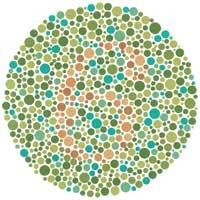From "resurrecting" colors

Color blindness is a genetic error that causes the inability to differentiate colors. In general, people with this disability mix green with red, but perceive more shades of purple than people without color blindness and are able to see camouflaged objects.
The gene that presents this defect in humans is hereditary and recessive and is associated with the X chromosome. That is, if a man receives a wrong X chromosome, he will be daltonic. However, a woman needs two defective chromosomes to be daltonic, but she will only carry it. Therefore, most daltonics are men.
Disability is chronic, or at least it was until scientists at the University of Washington cured daltonism to two monkeys.

Most daltonics do not distinguish between red and green. A daltonic would not see the number 6 in this photo (Photo: Ishihara).
A world painted in colors
In South American squirrel monkeys, all males are daltonics. These apes need the two versions of the gene called opsine to distinguish between red and green, as each gives them the ability to see one of the colors. This gene, however, is found on the X chromosome and males have a single X chromosome. Therefore, they have a single version of the gene and are therefore colorless. Females, however, have two X chromosomes, so they are more likely to see colors.
In the search for a possible treatment for human daltonism, visual field scientist Jay Neitz and his colleagues joined six squirrel monkeys, four males and two females for control. Scientists tested monkeys daily for a year, adapting to animals a test to detect daltonism in humans. On a screen full of colored dots they had to detect a stain of different color and as a reward they received the grape juice. The results of the tests showed that females saw colors as human, while males did not distinguish red from green from gray background.
Once the vision of each monkey was determined, scientists began genetic testing with two monkeys. The human pigment gene for red was introduced into a virus vector and viruses were introduced into the back of the retinas of monkeys called Dalton and Sam.

Color blindness is a genetic error that causes the inability to differentiate colors. (Photo s tsui).
Twenty weeks later the results of the color tests began to change. On the color dots screen, Dalton and Sam began to distinguish green and red spots, as did the females.
Before the tests, scientists were not very optimistic. Unlike the flexible brains of young animals, the brains of adults are much stiffer and need more time to make new connections. Many people who have become blind as a child, for example, when they have matured, remain blind even with cured eyes, as their brains have not developed the necessary circuits to process what they see.
But researchers find that the brain and retina have more plasticity than they expected. It has been proven that these dalmatian animals maintain color processing circuits in the brain. The introduced gene only sends new information to the circuits.
Two years after the experiment, monkeys continue to distinguish all colors. In view of success, scientists believe that genetic therapy can be used to cure more serious diseases.
Published in 7K.
Buletina
Bidali zure helbide elektronikoa eta jaso asteroko buletina zure sarrera-ontzian











